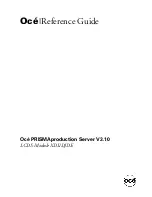
Communications
PcOS Series 90PLUS
Programmer's Guide
Miscellaneous
Page 154
Rev M
12/16/99
8.5.4
Off-line Active
There is a configuration flag that prevents the printer from going off-line (in most cases). Off-line mode
allows the application to query the printer for status rather than assume a status from the control signals.
The feature allows the host application to query the printer at all times except when there is no power; the
input buffer is full; or there is a hard failure. For example, if the printer’s cover is opened, the printer will
stop printing but will still accept data and inquire commands. The inquire cover status command would
then return cover open.
The only hard failures are no power or a printer fault. If the printer is off-line, then either the input buffer
is full, or there is a hard fault. The host application should not allow the input buffer to fill.
8.6
Programmer’s Notes
When the serial port is being used, it is important that the output lines from the printer not be shorted or back
driven. If the signals are not to be used, they should be left open.
Pins 3, 4, and 7 are outputs from the printer. If any one of these signals is grounded or back driven, the other
two outputs will be degraded.
If the printer is to be configured by the host with remote configuration, a good time to configure the printer is
during system setup or software update.
The printer should be power cycled after configuration to assure that the new configuration takes effect.
In serial mode, one-line mode should be avoided, particularly in XON/XOFF mode. The high-speed FIFO
input buffer makes one-line mode difficult to process.
If the MICR option is selected, the printer must wait for the read amplifiers in the MICR module to stabilize.
The printer will appear operational during this time and will accept data. The printer will not, however,
process any data until the MICR reader is ready. This can take up to 20 seconds depending on the temperature.
If the MICR reader or knife module fails at any time, the configuration can be changed to deactivate the
option. This will allow the printer to be used without the option until the printer can be repaired.
The Series 90PLUS Printer is equipped with fault detection circuits. These circuits prevent the printer from
destroying itself if the software or hardware fails. (This eliminates the need for an operator accessible fuse.
The printer should never need to have the fuse replaced unless the power supply has a catastrophic failure).
The detection circuit is termed “watchdog monitor.” These circuits monitor the print head, carriage motor, slip
paper drive, receipt paper drive, and total power consumption. If the watchdog monitor detects a fault, it
requests the power supply to shutdown. After the supply shutdown, the watchdog monitor will wait for about
500 milliseconds and restart. The effect is to completely reset the printer. If the fault still exists, the power
supply will shutdown again. An example of a problem that would be detected by the watchdog monitor would
be if the carriage motor was on but no head movement was detected. This of course should never happen.
The Series 90PLUS Printer is not intended to be a graphic printer. The watchdog monitor will not allow heavy
black printing on a single print pass. (It is sensed as too much power usage). To allow the printer to print
graphics, the printer detects heavy graphic print before it is printed and switches to a low power two-pass
mode. This slows the print time but allows almost any graphic to be printed.
Summary of Contents for PcOS series 90plus
Page 1: ...P OS c SERIES 90PLUS Receipt Validation Journal Printers PROGRAMMER S GUIDE Rev M PN 100 7586 ...
Page 2: ......
Page 6: ...PcOS Series 90PLUS Programmer s Guide Page iv Rev M 12 16 99 ...
Page 139: ...Programmer s Guide PcOS Series 90PLUS Product Self Tests 12 16 99 Rev M Page 127 73 Italian ...
Page 179: ......
Page 180: ...INSERT PN 100 7307 Rev M 12 16 99 ...















































